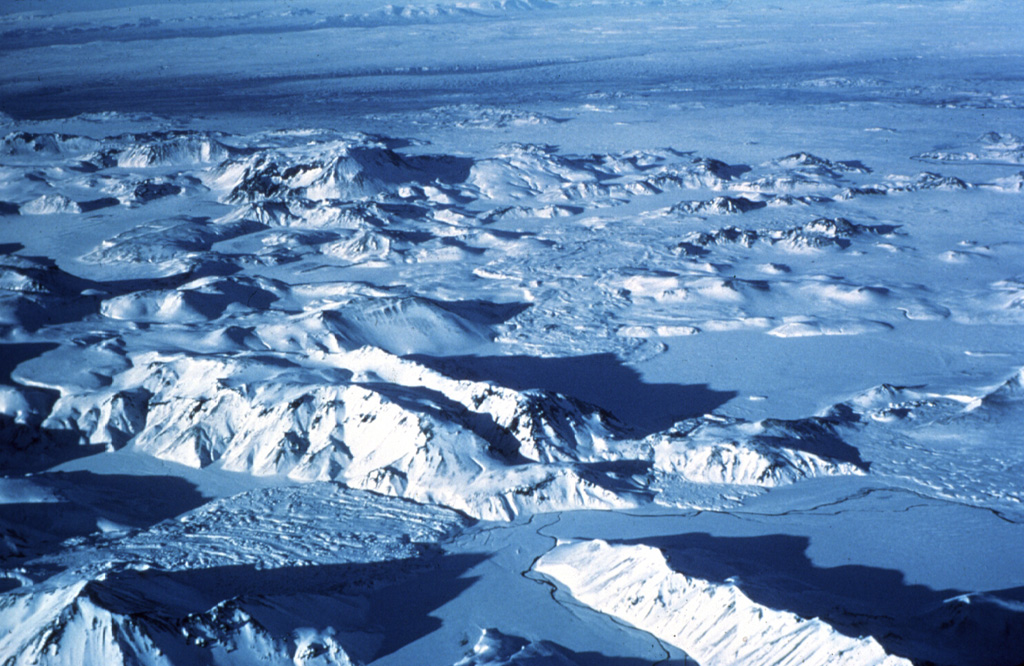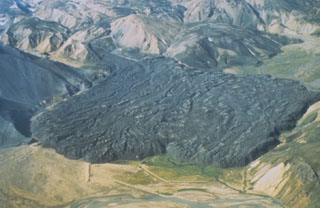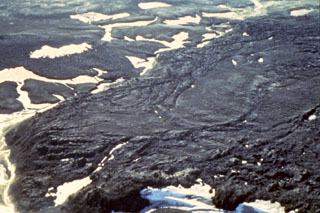Due to the US Government shutdown, the Smithsonian is temporarily closed. The Global Volcanism Program website will remain available but will not be monitored or updated. Status updates will be available on the Smithsonian homepage.



The Global Volcanism Program has no activity reports available for Torfajökull.
The Global Volcanism Program has no Weekly Reports available for Torfajökull.
The Global Volcanism Program has no Bulletin Reports available for Torfajökull.
|
|
||||||||||||||||||||||||||||
There is data available for 10 confirmed eruptive periods.
1477 Mar Confirmed Eruption (Explosive / Effusive) VEI: 2 (?)
| Episode 1 | Eruption (Explosive / Effusive) | N of caldera (Namshraun, Laugahraun) | ||||||||||||||||||||||||||||
|---|---|---|---|---|---|---|---|---|---|---|---|---|---|---|---|---|---|---|---|---|---|---|---|---|---|---|---|---|---|
| 1477 Mar - Unknown | Evidence from Observations: Reported | ||||||||||||||||||||||||||||
|
List of 4 Events for Episode 1 at N of caldera (Namshraun, Laugahraun)
|
|||||||||||||||||||||||||||||
1170 (?) Confirmed Eruption (Explosive / Effusive)
| Episode 1 | Eruption (Explosive / Effusive) | W side of caldera (Hrafntinnuhraun) | ||||||||||||||||||
|---|---|---|---|---|---|---|---|---|---|---|---|---|---|---|---|---|---|---|---|
| 1170 (?) - Unknown | Evidence from Correlation: Tephrochronology | ||||||||||||||||||
|
List of 2 Events for Episode 1 at W side of caldera (Hrafntinnuhraun)
|
|||||||||||||||||||
0870 (?) Confirmed Eruption (Explosive / Effusive) VEI: 3
| Episode 1 | Eruption (Explosive / Effusive) | W side of caldera (Hrafntinnuhraun) | |||||||||||||||||||||||
|---|---|---|---|---|---|---|---|---|---|---|---|---|---|---|---|---|---|---|---|---|---|---|---|---|
| 0870 (?) - Unknown | Evidence from Correlation: Tephrochronology | |||||||||||||||||||||||
|
List of 3 Events for Episode 1 at W side of caldera (Hrafntinnuhraun)
|
||||||||||||||||||||||||
0150 ± 100 years Confirmed Eruption (Explosive / Effusive) VEI: 3
| Episode 1 | Eruption (Explosive / Effusive) | N of caldera (Domadalshraun) | ||||||||||||||||||||||||||||
|---|---|---|---|---|---|---|---|---|---|---|---|---|---|---|---|---|---|---|---|---|---|---|---|---|---|---|---|---|---|
| 0150 ± 100 years - Unknown | Evidence from Correlation: Tephrochronology | ||||||||||||||||||||||||||||
|
List of 4 Events for Episode 1 at N of caldera (Domadalshraun)
|
|||||||||||||||||||||||||||||
1150 BCE ± 100 years Confirmed Eruption (Explosive / Effusive)
| Episode 1 | Eruption (Explosive / Effusive) | N of caldera (Domadalshraun) | |||||||||||||
|---|---|---|---|---|---|---|---|---|---|---|---|---|---|---|
| 1150 BCE ± 100 years - Unknown | Evidence from Correlation: Tephrochronology | |||||||||||||
|
List of 1 Events for Episode 1 at N of caldera (Domadalshraun)
|
||||||||||||||
1550 BCE ± 500 years Confirmed Eruption (Explosive / Effusive)
| Episode 1 | Eruption (Explosive / Effusive) | W side of caldera (Markafljot domes) | |||||||||||||
|---|---|---|---|---|---|---|---|---|---|---|---|---|---|---|
| 1550 BCE ± 500 years - Unknown | Evidence from Correlation: Tephrochronology | |||||||||||||
|
List of 1 Events for Episode 1 at W side of caldera (Markafljot domes)
|
||||||||||||||
4550 BCE ± 500 years Confirmed Eruption (Explosive / Effusive)
| Episode 1 | Eruption (Explosive / Effusive) | N of caldera (Haolduhraun) | |||||||||||||
|---|---|---|---|---|---|---|---|---|---|---|---|---|---|---|
| 4550 BCE ± 500 years - Unknown | Evidence from Correlation: Tephrochronology | |||||||||||||
|
List of 1 Events for Episode 1 at N of caldera (Haolduhraun)
|
||||||||||||||
4850 BCE (?) Confirmed Eruption (Explosive / Effusive)
| Episode 1 | Eruption (Explosive / Effusive) | W of caldera (Laufafell domes) | |||||||||||||
|---|---|---|---|---|---|---|---|---|---|---|---|---|---|---|
| 4850 BCE (?) - Unknown | Evidence from Correlation: Tephrochronology | |||||||||||||
|
List of 1 Events for Episode 1 at W of caldera (Laufafell domes)
|
||||||||||||||
5050 BCE (?) Confirmed Eruption (Explosive / Effusive)
| Episode 1 | Eruption (Explosive / Effusive) | Hrafntinnusker and Domadalshraun | |||||||||||||
|---|---|---|---|---|---|---|---|---|---|---|---|---|---|---|
| 5050 BCE (?) - Unknown | Evidence from Correlation: Tephrochronology | |||||||||||||
|
List of 1 Events for Episode 1 at Hrafntinnusker and Domadalshraun
|
||||||||||||||
6050 BCE (?) Confirmed Eruption (Explosive / Effusive)
| Episode 1 | Eruption (Explosive / Effusive) | W side of caldera (Slettahraun) | |||||||||||||
|---|---|---|---|---|---|---|---|---|---|---|---|---|---|---|
| 6050 BCE (?) - Unknown | Evidence from Correlation: Tephrochronology | |||||||||||||
|
List of 1 Events for Episode 1 at W side of caldera (Slettahraun)
|
||||||||||||||
This compilation of synonyms and subsidiary features may not be comprehensive. Features are organized into four major categories: Cones, Craters, Domes, and Thermal Features. Synonyms of features appear indented below the primary name. In some cases additional feature type, elevation, or location details are provided.
Cones |
||||
| Feature Name | Feature Type | Elevation | Latitude | Longitude |
| Bláhnúkur | Tuya | |||
| Gvendarhyran | Tuya | |||
| Illihnúkur | Tuya | |||
| Kirkjufell | Tuya | |||
| Raudfossafjöll | Tuya | |||
Craters |
||||
| Feature Name | Feature Type | Elevation | Latitude | Longitude |
| Domadalshraun | Fissure vent | 680 m | 64° 2' 0.00" N | 19° 7' 0.00" W |
| Grakolluhraun | Fissure vent | 64° 2' 0.00" N | 19° 3' 0.00" W | |
| Haolduhraun | Fissure vent | 64° 0' 0.00" N | 19° 10' 0.00" W | |
| Hraftinnuhraun | Crater Row | 944 m | 63° 57' 0.00" N | 19° 16' 0.00" W |
| Laufahraun | Fissure vent | 63° 55' 0.00" N | 19° 25' 0.00" W | |
| Laugahraun | Crater Row | 63° 59' 0.00" N | 19° 5' 0.00" W | |
| Merkurhraun | Fissure vent | 64° 8' 0.00" N | 19° 33' 0.00" W | |
| Namshraun | Crater Row | 64° 1' 0.00" N | 19° 2' 0.00" W | |
| Slettahraun | Fissure vent | 63° 57' 0.00" N | 19° 13' 0.00" W | |
Domes |
||||
| Feature Name | Feature Type | Elevation | Latitude | Longitude |
| Hraftinnusker | Dome | 1140 m | 63° 56' 0.00" N | 19° 11' 0.00" W |
| Laufafell | Dome | 63° 56' 0.00" N | 19° 21' 0.00" W | |
| Markarfljot | Dome | 63° 57' 0.00" N | 19° 20' 0.00" W | |
 The viscous Laugahraun lava flow was emplaced in 1477 CE just inside the northern rim of Torfajökull caldera. This thick flow extends for about 2 km, and at its widest (left to right in this image), is about 1.3 km. Other small lava flows were produced at the same time as the Laugahraun lava flow: the Námshraun and Norðumámshraun lavas to the northeast just outside the caldera rim, and the Frostastaðahraun further north on the fissure system. The light-colored deposits surrounding the darker lava flow are rhyolitic volcanics.
The viscous Laugahraun lava flow was emplaced in 1477 CE just inside the northern rim of Torfajökull caldera. This thick flow extends for about 2 km, and at its widest (left to right in this image), is about 1.3 km. Other small lava flows were produced at the same time as the Laugahraun lava flow: the Námshraun and Norðumámshraun lavas to the northeast just outside the caldera rim, and the Frostastaðahraun further north on the fissure system. The light-colored deposits surrounding the darker lava flow are rhyolitic volcanics. The silicic Hrafntinnuhraun eruption occurred in about 877 CE, producing about 0.18 km3 of lava and 0.4 km3 of tephra. An eruption column of up to 20 km high was associated with this Plinian eruption. The Hrafntinnuhraun lava flow stretches from the bottom left to top right in this image, with a stream running around its base on the left reflecting the sun.
The silicic Hrafntinnuhraun eruption occurred in about 877 CE, producing about 0.18 km3 of lava and 0.4 km3 of tephra. An eruption column of up to 20 km high was associated with this Plinian eruption. The Hrafntinnuhraun lava flow stretches from the bottom left to top right in this image, with a stream running around its base on the left reflecting the sun. The Torfajökull central volcano is cut by a 12 x 18 km caldera that formed during the Pleistocene. Torfajökull is of one of the largest areas of silicic and intermediate volcanism in Iceland. The Laugahraun (lower left) and Domadalshraun (right center) lava flows, seen here from the SE, are located just within and north of, respectively, the northern caldera rim. At least 12 eruptions have occurred in the last 9,000 years with activity concentrated in the west.
The Torfajökull central volcano is cut by a 12 x 18 km caldera that formed during the Pleistocene. Torfajökull is of one of the largest areas of silicic and intermediate volcanism in Iceland. The Laugahraun (lower left) and Domadalshraun (right center) lava flows, seen here from the SE, are located just within and north of, respectively, the northern caldera rim. At least 12 eruptions have occurred in the last 9,000 years with activity concentrated in the west.The following 5 samples associated with this volcano can be found in the Smithsonian's NMNH Department of Mineral Sciences collections, and may be availble for research (contact the Rock and Ore Collections Manager). Catalog number links will open a window with more information.
| Catalog Number | Sample Description | Lava Source | Collection Date |
|---|---|---|---|
| NMNH 117551-114 | Unidentified | -- | -- |
| NMNH 117551-115 | Unidentified | -- | -- |
| NMNH 117551-54 | Unidentified | Domadalshraun Lava Field | -- |
| NMNH 117551-55 | Obsidian | Hrafntinnuhraun | -- |
| NMNH 117551-56 | Obsidian | Laugahraun lava flow | -- |
| Catalogue of Icelandic Volcanoes (Link to Torfajökull) | The Catalogue of Icelandic Volcanoes is an interactive, web-based tool, containing information on volcanic systems that belong to the active volcanic zones of Iceland. It is a collaboration of the Icelandic Meteorological Office (the state volcano observatory), the Institute of Earth Sciences at the University of Iceland, and the Civil Protection Department of the National Commissioner of the Iceland Police, with contributions from a large number of specialists in Iceland and elsewhere. This official publication is intended to serve as an accurate and up-to-date source of information about active volcanoes in Iceland and their characteristics. The Catalogue forms a part of an integrated volcanic risk assessment project in Iceland GOSVÁ (commenced in 2012), as well as being part of the effort of FUTUREVOLC (2012-2016) on establishing an Icelandic volcano supersite. |
| Copernicus Browser | The Copernicus Browser replaced the Sentinel Hub Playground browser in 2023, to provide access to Earth observation archives from the Copernicus Data Space Ecosystem, the main distribution platform for data from the EU Copernicus missions. |
| MIROVA | Middle InfraRed Observation of Volcanic Activity (MIROVA) is a near real time volcanic hot-spot detection system based on the analysis of MODIS (Moderate Resolution Imaging Spectroradiometer) data. In particular, MIROVA uses the Middle InfraRed Radiation (MIR), measured over target volcanoes, in order to detect, locate and measure the heat radiation sourced from volcanic activity. |
| MODVOLC Thermal Alerts | Using infrared satellite Moderate Resolution Imaging Spectroradiometer (MODIS) data, scientists at the Hawai'i Institute of Geophysics and Planetology, University of Hawai'i, developed an automated system called MODVOLC to map thermal hot-spots in near real time. For each MODIS image, the algorithm automatically scans each 1 km pixel within it to check for high-temperature hot-spots. When one is found the date, time, location, and intensity are recorded. MODIS looks at every square km of the Earth every 48 hours, once during the day and once during the night, and the presence of two MODIS sensors in space allows at least four hot-spot observations every two days. Each day updated global maps are compiled to display the locations of all hot spots detected in the previous 24 hours. There is a drop-down list with volcano names which allow users to 'zoom-in' and examine the distribution of hot-spots at a variety of spatial scales. |
|
WOVOdat
Single Volcano View Temporal Evolution of Unrest Side by Side Volcanoes |
WOVOdat is a database of volcanic unrest; instrumentally and visually recorded changes in seismicity, ground deformation, gas emission, and other parameters from their normal baselines. It is sponsored by the World Organization of Volcano Observatories (WOVO) and presently hosted at the Earth Observatory of Singapore.
GVMID Data on Volcano Monitoring Infrastructure The Global Volcano Monitoring Infrastructure Database GVMID, is aimed at documenting and improving capabilities of volcano monitoring from the ground and space. GVMID should provide a snapshot and baseline view of the techniques and instrumentation that are in place at various volcanoes, which can be use by volcano observatories as reference to setup new monitoring system or improving networks at a specific volcano. These data will allow identification of what monitoring gaps exist, which can be then targeted by remote sensing infrastructure and future instrument deployments. |
| Volcanic Hazard Maps | The IAVCEI Commission on Volcanic Hazards and Risk has a Volcanic Hazard Maps database designed to serve as a resource for hazard mappers (or other interested parties) to explore how common issues in hazard map development have been addressed at different volcanoes, in different countries, for different hazards, and for different intended audiences. In addition to the comprehensive, searchable Volcanic Hazard Maps Database, this website contains information about diversity of volcanic hazard maps, illustrated using examples from the database. This site is for educational purposes related to volcanic hazard maps. Hazard maps found on this website should not be used for emergency purposes. For the most recent, official hazard map for a particular volcano, please seek out the proper institutional authorities on the matter. |
| IRIS seismic stations/networks | Incorporated Research Institutions for Seismology (IRIS) Data Services map showing the location of seismic stations from all available networks (permanent or temporary) within a radius of 0.18° (about 20 km at mid-latitudes) from the given location of Torfajökull. Users can customize a variety of filters and options in the left panel. Note that if there are no stations are known the map will default to show the entire world with a "No data matched request" error notice. |
| UNAVCO GPS/GNSS stations | Geodetic Data Services map from UNAVCO showing the location of GPS/GNSS stations from all available networks (permanent or temporary) within a radius of 20 km from the given location of Torfajökull. Users can customize the data search based on station or network names, location, and time window. Requires Adobe Flash Player. |
| DECADE Data | The DECADE portal, still in the developmental stage, serves as an example of the proposed interoperability between The Smithsonian Institution's Global Volcanism Program, the Mapping Gas Emissions (MaGa) Database, and the EarthChem Geochemical Portal. The Deep Earth Carbon Degassing (DECADE) initiative seeks to use new and established technologies to determine accurate global fluxes of volcanic CO2 to the atmosphere, but installing CO2 monitoring networks on 20 of the world's 150 most actively degassing volcanoes. The group uses related laboratory-based studies (direct gas sampling and analysis, melt inclusions) to provide new data for direct degassing of deep earth carbon to the atmosphere. |
| Large Eruptions of Torfajökull | Information about large Quaternary eruptions (VEI >= 4) is cataloged in the Large Magnitude Explosive Volcanic Eruptions (LaMEVE) database of the Volcano Global Risk Identification and Analysis Project (VOGRIPA). |
| EarthChem | EarthChem develops and maintains databases, software, and services that support the preservation, discovery, access and analysis of geochemical data, and facilitate their integration with the broad array of other available earth science parameters. EarthChem is operated by a joint team of disciplinary scientists, data scientists, data managers and information technology developers who are part of the NSF-funded data facility Integrated Earth Data Applications (IEDA). IEDA is a collaborative effort of EarthChem and the Marine Geoscience Data System (MGDS). |